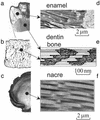Materials become insensitive to flaws at nanoscale: lessons from nature
- PMID: 12732735
- PMCID: PMC156246
- DOI: 10.1073/pnas.0631609100
Materials become insensitive to flaws at nanoscale: lessons from nature
Abstract
Natural materials such as bone, tooth, and nacre are nanocomposites of proteins and minerals with superior strength. Why is the nanometer scale so important to such materials? Can we learn from this to produce superior nanomaterials in the laboratory? These questions motivate the present study where we show that the nanocomposites in nature exhibit a generic mechanical structure in which the nanometer size of mineral particles is selected to ensure optimum strength and maximum tolerance of flaws (robustness). We further show that the widely used engineering concept of stress concentration at flaws is no longer valid for nanomaterial design.
Figures




References
-
- Currey J D. Proc R Soc London Ser B. 1977;196:443–463.
-
- Menig R, Meyers M H, Meyers M A, Vecchio K S. Mater Sci Eng. 2001;297:203–211.
-
- Menig R, Meyers M H, Meyers M A, Vecchio K S. Acta Mater. 2000;48:2383–2398.
-
- Kamat S, Su X, Ballarini R, Heuer A H. Nature. 2000;405:1036–1040. - PubMed
-
- Jackson A P, Vincent J F V, Turner R M. Proc R Soc London Ser B. 1988;234:415–440.
Publication types
MeSH terms
Substances
LinkOut - more resources
Full Text Sources
Other Literature Sources
Medical

